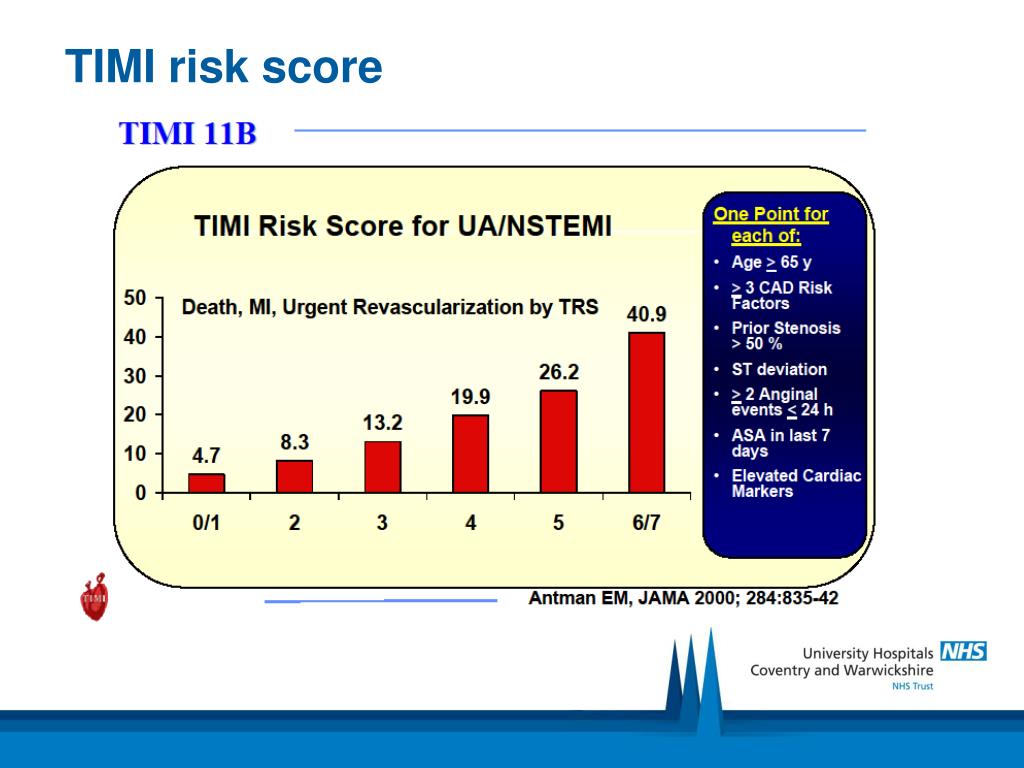

16 However, as all three risk scores are derived from ACS patients with a high probability of having an ACS event, it is unknown whether they apply to unselected patients with undifferentiated cardiac chest pain. 13, 14 The GRACE risk score has superior predictive accuracy, compared with the TIMI or PURSUIT scores, in an ACS population. 14, 15 The population comprises 68 937 patients with a diagnosis of ACS, and a prognostic model which predicts the risk of death and myocardial infarction has been established (c index 0.84 for death).
#Timi risk score full
The Global Registry of Acute Coronary Events (GRACE) is a large multinational registry encompassing the full spectrum of acute coronary disease. 13 Thus, a more integrated approach to risk prediction is required. 12 Binary decisions based upon single tests are not appropriate, as a spectrum of characteristics contributes to risk in ACS. 10, 11 However, the negative predictive value of troponin on arrival is poor, because of the time required for efflux of this marker from cardiomyocytes. Risk stratification in emergency departments can reduce hospital admissions, and the introduction of troponin assays has aided this process. 7, 8 Conversely, up to 6% of those discharged from the emergency department have a ‘missed’ myocardial infarction, 9 and up to a third of those who evolve MI do not have typical chest pains. 6 Fewer than half of the patients who are admitted with chest pain have a final diagnosis of ACS. 4, 5 Conversely, pains of atypical distribution may herald acute infarction, and up to a third of those who evolve MI do not have typical chest pains. 3 Risk stratification cannot therefore rely simply on the presence of ST elevation, and more accurate risk prediction tools are required.Īre clinical features sufficient for risk stratification? A clinical diagnosis of ‘suspected ACS’ has low diagnostic accuracy when based only on the ECG and clinical symptoms. ST elevation has high specificity but low sensitivity for infarction, and three-quarters of those with acute coronary symptoms do not have ST elevation on presentation. 2 Differentiating ACS from suspected cardiac chest pain represents a major clinical diagnostic challenge, especially among those without ST elevation on the electrocardiogram (ECG). 1 Although the age-adjusted incidence of ST elevation myocardial infarction (MI) is falling, the number of people being hospitalized with suspected acute coronary syndrome (ACS) is increasing.

The GRACE score predicted an ACS discharge diagnosis ( p < 0.001) and duration of hospital stay ( p < 0.001).ĭiscussion: In unselected patients presenting with suspected cardiac pain, the GRACE risk score is superior to the TIMI risk score in predicting major cardiac events, and both risk scores are superior to using ECG and troponin findings at presentation.Ĭhest pain is the most common reason for emergency ambulance call-outs, and accounts for 27% of emergency medical admissions in the UK (149 000 admissions/year). Both GRACE ( p < 0.001) and TIMI scores ( p < 0.001) predicted death/MI/revascularization (and the composite including re-admission), but the GRACE score was superior to the TIMI score for predicting major cardiac events (z = 2.05), and both scores were superior to clinical evaluation (ROC areas 0.82, 0.74 and 0.55 respectively). Results: Overall 54 patients (15.6%) experienced a major cardiac event (16 deaths, seven myocardial infarctions (MIs), one emergency revascularization) or emergency re-admission ( n = 30) within 3 months. Receiver operating characteristic (ROC) curves were plotted for TIMI and GRACE risk scores and clinical evaluation. The main outcome measures were death, non-fatal myocardial infarction and emergency revascularization, in hospital and at 3 months. Methods: We recruited 347 sequential patients with suspected cardiac pain presenting to a large teaching hospital. It is uncertain whether risk scores derived from ACS populations apply to unselected patients with chest pain.Īim: To determine the predictive accuracies of the GRACE risk score, the TIMI risk score and clinical evaluation in unselected patients with suspected cardiac pain. Clinical evaluation may lack sufficient precision, leading to unnecessary admission or inappropriate discharge. Background: Identifying which patients presenting with undifferentiated chest pain are at risk of major cardiac events is a major clinical challenge.


 0 kommentar(er)
0 kommentar(er)
